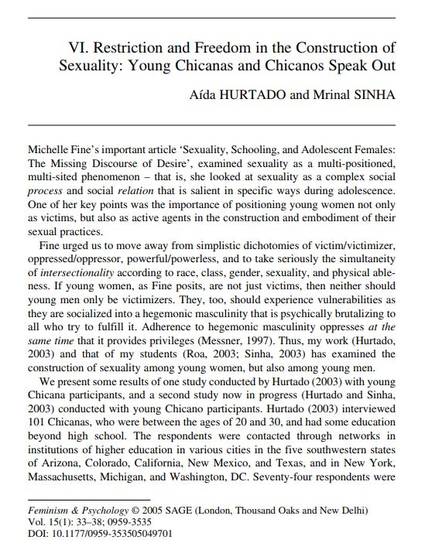
Article
Restriction and Freedom in the Construction of Sexuality: Young Chicanas and Chicanos Speak Out
Feminism & Psychology
(2005)
Abstract
Michelle Fine’s important article ‘Sexuality, Schooling, and Adolescent Females: The Missing Discourse of Desire’, examined sexuality as a multi-positioned, multi-sited phenomenon – that is, she looked at sexuality as a complex social process and social relation that is salient in specific ways during adolescence. One of her key points was the importance of positioning young women not only as victims, but also as active agents in the construction and embodiment of their sexual practices.
Fine urged us to move away from simplistic dichotomies of victim/victimizer, oppressed/oppressor, powerful/powerless, and to take seriously the simultaneity of intersectionality according to race, class, gender, sexuality, and physical ableness. If young women, as Fine posits, are not just victims, then neither should young men only be victimizers. They, too, should experience vulnerabilities as they are socialized into a hegemonic masculinity that is psychically brutalizing to all who try to fulfill it. Adherence to hegemonic masculinity oppresses at the same time that it provides privileges (Messner, 1997). Thus, my work (Hurtado, 2003) and that of my students (Roa, 2003; Sinha, 2003) has examined the construction of sexuality among young women, but also among young men.
We present some results of one study conducted by Hurtado (2003) with young Chicana participants, and a second study now in progress (Hurtado and Sinha, 2003) conducted with young Chicano participants. Hurtado (2003) interviewed 101 Chicanas, who were between the ages of 20 and 30, and had some education beyond high school. The respondents were contacted through networks in institutions of higher education in various cities in the five southwestern states of Arizona, Colorado, California, New Mexico, and Texas, and in New York, Massachusetts, Michigan, and Washington, DC. Seventy-four respondents were attending institutions of higher education such as Harvard University, the University of Michigan, and the University of California, Santa Cruz. Twentyseven respondents had graduated (some with a bachelor’s degree and most with advanced and professional degrees). The respondents were interviewed in focus groups of two and three participants. The interviews were audio- and video-taped and were transcribed and coded by bilingual/bicultural research assistants.
The Hurtado and Sinha study (2003) is designed to mirror, with Chicano men, the preceding research design, with 20 interviews in California already completed, transcribed, and coded by bilingual/bicultural research assistants. Our goal is to interview 100 young Chicanos. We utilize these data to discuss several similarities and differences between the sexuality of young Chicanas and Chicanos as they describe being socialized to become ‘women’ and ‘men’.
Disciplines
Publication Date
2005
DOI
10.1177/0959353505049701
Citation Information
Aída Hurtado and Mrinal Sinha. "Restriction and Freedom in the Construction of Sexuality: Young Chicanas and Chicanos Speak Out" Feminism & Psychology Vol. 15 Iss. 1 (2005) p. 33 - 38 Available at: http://works.bepress.com/mrinal-sinha/1/
